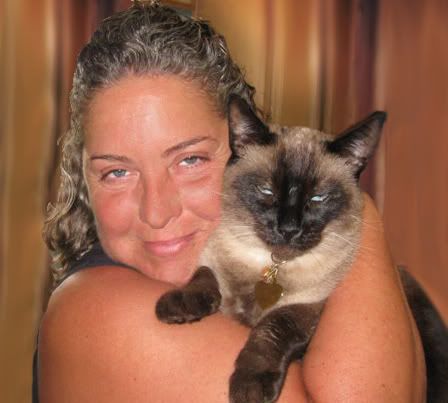 Right: Mr B marches over for school!
Right: Mr B marches over for school!
I enjoy animal training boot camps. It is the ideal training scenario for me and the animal because it is sans the owner’s habits and the training complications involved when working with the owner.
My initial concern over Mr B was related to the behavior modification of his biting and scratching habits.
However, since I’ve been in the area he and I have become buddies.
His interest in me is purely in the fact that he learns things and LIKES learning things. Plus he earns good things like food.
My interest in him is that he is a smart, feisty student.
Most animals are great at behavior modification. They learn how to manipulate (read “train”) their owners to get what they want, when they want it, and how they want it.
Most pet owners are great at obliging–which is why many pet households experience so many behavior problems.
Humans tend to not recognize when they are rewarding bad behavior and fail to address it until it becomes a problem.
Mr B’s bad habits were entrenched from his previous life of which we know nothing about.
He is the sweetest kitty in the world BUT he is also a very determined character when it comes to getting just what he wants.
I should have known–all my animal students tend to be really smart or really sensitive–or a combination of the two. This is why they are difficult.
Anyway, his mom has owned cats most of her life and provides a great cat household but, like most people, her interpretation of animal behavior and motivation is skewed (at least from the view of an animal trainer or behaviorist).
She is in the majority because most pet owning people don’t think like an animal, they think like a human.
The issue is that animals are not humans and so many of those assumptions, when it comes to behavior and the motivation behind that behavior, are usually incorrect.
That wrong assumption and the actions that follow is why people have animals that behave badly.
Animals living with humans can, and should, have good manners–and they can if they are raised right and then put into school.
Now Mr B has a time clock that is amazingly accurate. Feed him at a certain time and he would be back at the food bowl the next day at that exact time. It doesn’t matter if it was a snack or a feeding–he will be there.
Also, he does not give up.
Mr B will persist until he gets what he wants–so, if his human relents, it just raised the bar to that level.
Do you get that?
Either ignore the behavior until it stops and YOU initiate the behavior at a much later time–or just relent right away.
Why?
Because if you delay in acting, when you finally give in, you are rewarding the persistent demand.
Hence the behavior gets worse or more intense.
Get it?
So, what happened was that Mr B arrived knowing he could get what he wanted by being persistent and he had no real inhibitions about the use of his claws and teeth.
Some animals do not learn restraint (and many other things) at a young age and rough behavior, normally mitigated by their siblings or mother, continues since proper behavior skills are not learned if the animal is removed too early from the litter.
We suspect Mr B’s problem was that he lived in a household that allowed rough-housing, that he lacked any restraints to begin with, and so he learned that the behavior was acceptable.
It is not!
When I first came to meet Mr B, I had a 60cc syringe concealed on my person. When he attempted to bite or bat me–squirt.
Guess what? Three bite/bat attempts, three squirts–and he did not do it again.
Now there is a whole discussion related to reprimands from out of the blue (not associated with the person or trainer) but that is a long post in itself for another time.
The point is, he “got” that his rough housing did not work for me, it was not acceptable and so he stopped.
Okay, here is the breakdown:
It was not fun.
It did not get interaction.
The water squirt wasn’t something he liked.
He controlled whether or not he got squirted by adapting his behavior.
Refraining from biting or batting means no squirting.
He learned biting and scratching had a consequence.
That consequence did not hurt him, wasn’t a big fuss, and was effective in stopping the behavior.
Now that the biting and scratching ceased–we could start training.
When he is in a training session Mr B purrs and purrs. This is because he enjoys figuring things out and getting food treats for doing the right thing.
The only consequence in his training now is the time variable.
I use the “window of opportunity” model so if he does not respond within a certain window of time–the session ends.
This means that I am not sitting around waiting for him to decide when he is going to respond–plus it gets him to engage in the training session instead of getting distracted.
There is no real negative–only the loss of opportunity and the chance for more reward.
But Mr B likes opportunity and I’ll share some of the actual training with you next.


